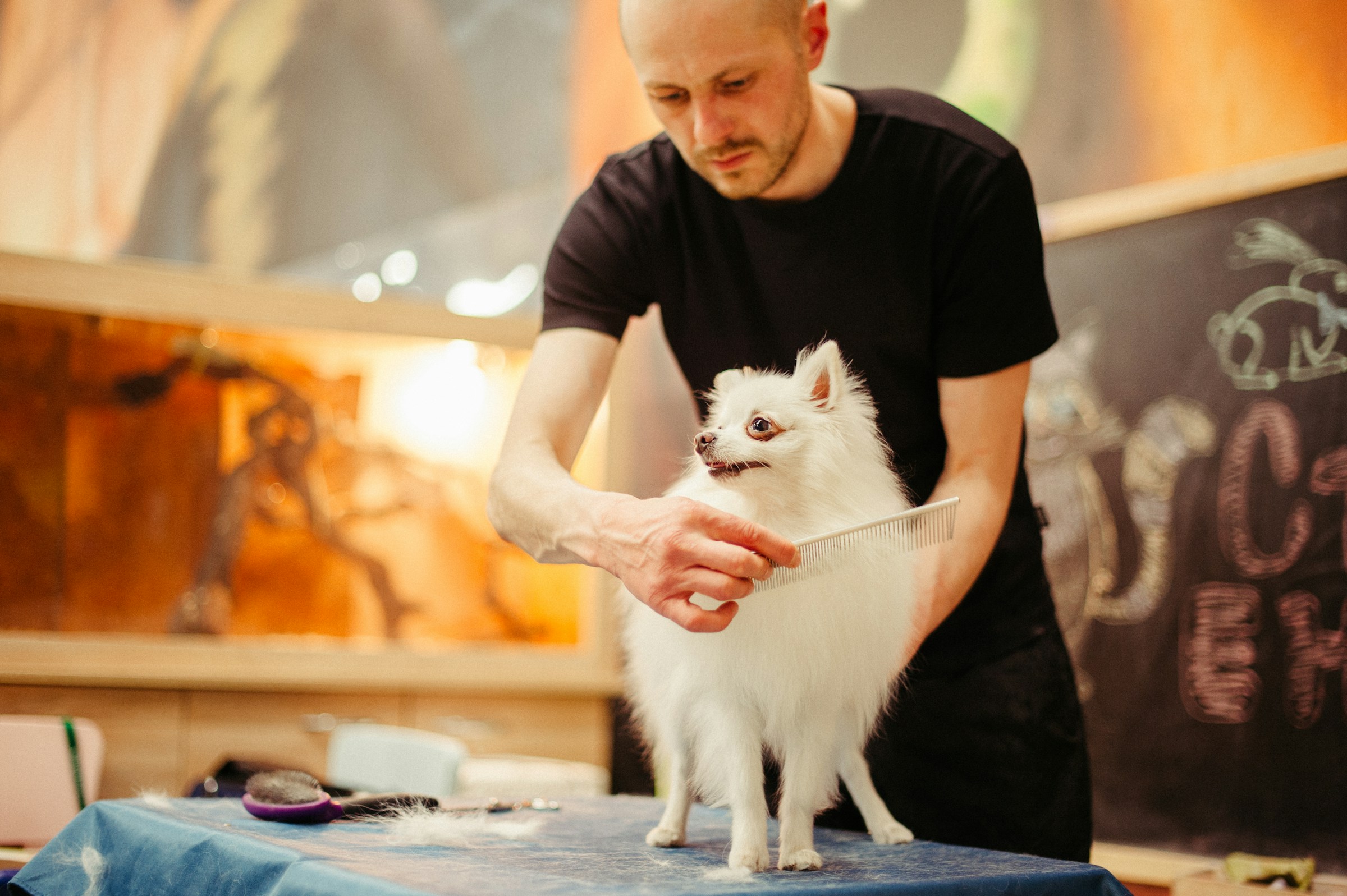Hey there, fellow pet lovers! I’m Jordan Lee, a 30-year-old certified groomer with five years of experience, and I’m thrilled to share my tips on grooming your dog at home.
I’ve had the pleasure of working with a wide range of pets in my career, and at home, I’m surrounded by my own furry (and feathered) crew: a golden retriever, a spaniel, a British short-hair cat, a Persian cat, a hamster, and a chatty African Grey parrot. This diverse experience has given me a unique perspective on pet care, and I’m here to help you keep your pup looking and feeling their best, without the hefty price tag of constant professional grooming.
Importance of regular grooming for your pet’s health
Grooming isn’t just about aesthetics (though who doesn’t love a sharp-looking dog?). It’s a vital part of keeping your pet healthy and comfortable. In my years as a groomer, I’ve seen how regular care can prevent painful issues like matted fur, ear infections, and overgrown nails—problems that can lead to expensive vet bills if ignored. Plus, it’s a wonderful way to bond with your dog.
With a little patience, the right tools, and a few treats, you can master the basics at home. Let’s dive into what you’ll need and how to tailor your routine to your dog’s coat type.
Why grooming is essential for your pet’s health:
- Prevents skin and coat issues: regular brushing distributes natural oils through your pet’s fur, keeping their coat shiny and their skin healthy. It also helps prevent painful matting, which can lead to skin infections if left unchecked. My Persian cat, for example, has a coat that mats easily, so daily brushing is a must to keep her comfortable.
- Reduces shedding: if you’ve ever found yourself vacuuming up tumbleweeds of fur, you’ll appreciate this one. Brushing removes loose hair before it ends up on your couch or clothes. My golden retriever sheds like crazy during certain seasons, but with regular de-shedding sessions, I’ve managed to keep the fur situation under control.
- Prevents nail and paw problems: overgrown nails can cause pain, affect your pet’s gait, and even lead to joint issues. Trimming nails regularly keeps your pet comfortable and mobile. I’ve seen dogs come into my grooming salon limping from nails that were too long—it’s an easy fix, but it’s so important.
- Supports dental health: dental care is often overlooked, but it’s critical. Periodontal disease can lead to serious health issues like heart disease. Brushing your pet’s teeth regularly (yes, even dogs and cats!) can prevent plaque buildup and keep their breath fresh. My spaniel used to hate teethbrushing, but with patience (and some tasty dog-safe toothpaste), it’s now part of our routine.
- Early detection of health issues: grooming gives you a chance to check for lumps, bumps, fleas, or other abnormalities. When I’m brushing my pets, I always take a moment to feel for anything unusual—it’s like a mini health check every time.
- Helps with pet-bonding: one of the best parts of grooming is how it strengthens your bond with your pet. My golden retriever, for example, absolutely loves being brushed. It’s our special time together—he’ll flop onto his back for belly rubs while I work through his coat.
Read more: how to add fiber to your dogs’ diet.
Cost-saving tips for at-home grooming
Professional grooming can be pricey, especially if you have multiple pets or a breed that needs frequent trims. Learning to groom at home can save you a ton of money over time. Here’s how to get started without breaking the bank:
- Invest in quality tools upfront: a good brush, clippers, and shears will last for years. I’ve had the same slicker brush for my retriever since I started grooming.
- Start small: if you’re nervous, begin with simple tasks like brushing or nail trimming before moving on to baths or haircuts.
- Watch tutorials: there are tons of free videos online from professional groomers (myself included—I’ve got a few on my YouTube channel!). They’ll walk you through the basics step by step.
- Be patient: it might take a few tries to get the hang of it, but don’t get discouraged. My first attempt at trimming my spaniel’s paws was… let’s just say uneven. But with practice, I got better—and so will you.
Read also: common senior dog behavior problems and how to manage them.
What grooming tools do I need?
After five years of grooming everything from my golden retriever’s thick coat to my hamster’s delicate fur, I’ve honed in on the essential tools for at-home dog grooming. Here’s what I recommend keeping in your kit:
- Brushes: a rubber-bristled brush is my go-to for short-haired dogs like my spaniel—it’s gentle and distributes natural oils for a shiny coat. For longer coats like my golden retriever’s, a wire slicker brush is a must to tackle tangles. A steel comb is perfect for detangling, and if your dog sheds a lot, a de-shedding tool will save your furniture!
- Nail clippers and/or Dremel grinder: dog-specific clippers are essential for safe trimming. I also love a Dremel grinder to smooth out nails—my dogs barely flinch when I use it.
- Styptic pencil: accidents happen (especially with squirmy pups), and this stops bleeding fast if you nick a nail too short.
- Toothbrush and dog-safe toothpaste: dental care is non-negotiable. I brush my dogs’ teeth weekly, and they’ve never had a dental issue.
- Cotton balls or soft cloths: these are great for gently cleaning around eyes and ears—I use them on my cats too.
- Blunt-ended shears and/or clippers with guide combs: perfect for safely trimming fur around paws, ears, and other sensitive spots.
- Dog-specific shampoo (and optional conditioner): human products can irritate their skin, so stick to pet-safe options. I’ve bathed everything from my parrot to my Persian cat, and trust me, pet-specific products make all the difference.
- Microfiber towel: dries quickly and is gentle on their coat—my go-to for drying my dogs.
- Hair dryer (optional): if your dog tolerates it, a low-heat setting speeds up drying. My golden loves the warm breeze, but my spaniel prefers to air-dry.
These tools have been my trusty companions through countless grooming sessions, and they’ll make your at-home routine a breeze.
See also: AI in veterinary diagnostics: How much should you trust them?
Simple grooming techniques you can try at home
If you’re new to grooming, don’t worry—it’s easier than you think. Here’s how to tackle these three key tasks:
Brushing
- Short-haired pets: Brush once a week with a rubber-bristled brush to remove loose fur and distribute oils.
- Long-haired pets: Brush daily with a slicker brush to prevent mats, followed by a comb to work out any tangles.
- Double-coated pets: Use a de-shedding tool weekly to manage shedding, especially during seasonal changes.
Pro tip: always brush before bathing—water can tighten mats and make them harder to remove.
Read also: telemedicine in veterinary care: a veterinarian’s guide to remote consultations.
Nail trimming
Use dog-specific clippers or a grinder. If using clippers, cut small amounts at a time to avoid the quick (the sensitive part inside the nail).
If you’re nervous, start by trimming just the tips and work your way up as you get more comfortable.
Reward your pet with treats and praise to make it a positive experience. My spaniel used to squirm, but now he sits still for treats!
Dental care
Use a dog- or cat-specific toothbrush and toothpaste. Start by letting your pet taste the toothpaste, then gently brush in circular motions. Aim for a few times a week—consistency is key. My golden retriever actually looks forward to it now (mostly for the toothpaste flavor!).
Here is another article: smart collars in pet care: a veterinarian’s evidence-based analysis.
How often should I brush and bathe my dog or cat?
With five years of grooming experience under my belt—and a household full of pets with wildly different coat types—I’ve learned that every dog needs a tailored approach.
Here’s you should brush your dog coat type:
- Short, smooth coats (like my spaniel or a dachshund): brush once a week with a rubber-bristled brush to keep their coat sleek and healthy.
- Long, silky, or curly coats (think shih tzus or poodles): brush daily with a wire slicker or rubber brush to prevent mats, then use a steel comb to work out any knots.
- Double coats (like my golden retriever or a Labrador): brush weekly, and add a de-shedding session with an undercoat rake to manage that fluffy undercoat—especially during shedding season!
How often you should bath your dog based on coat type:
- Long-haired dogs: they need a full grooming session (bath and trim) every 4 to 8 weeks to keep their coat manageable.
- Short-haired dogs: a monthly bath keeps them fresh and clean.
Pro tip: always brush before bathing—water tightens mats and makes them harder to remove. Use dog-specific shampoo and avoid getting it in their eyes or ears. For floppy-eared breeds like my spaniel, I check for redness or odor regularly, since they’re prone to infections. When drying, a microfiber towel is my favorite, though my golden retriever enjoys a low-heat blow-dry (my spaniel, not so much—he’s an air-dry guy).
Conclusion
Grooming is one of the best things you can do for your pet’s health, happiness, and your wallet. Whether you’re brushing out your dog’s coat, trimming your cat’s nails, or even giving your parrot a little spa day (yes, I’ve done that too!), regular grooming prevents health issues, strengthens your bond, and keeps your pet looking their best.
If you’re new to at-home grooming, start small and be patient with yourself and your pet. And if you ever feel stuck, don’t hesitate to reach out to a professional groomer for advice—we’re always happy to help. Here’s to many happy, healthy grooming sessions with your furry (or feathered) friend!

I’m a certified pet groomer with five years of experience, passionate about helping pet owners keep their furry friends happy and healthy. I run a bustling grooming salon where I work with dogs, cats, and even the occasional small pet, offering practical advice based on hands-on expertise. My home is a lively pet haven, shared with a golden retriever, a spaniel, a British short-hair, a Persian cat, a hamster, and an African Grey parrot—each teaching me something new about pet care daily.
